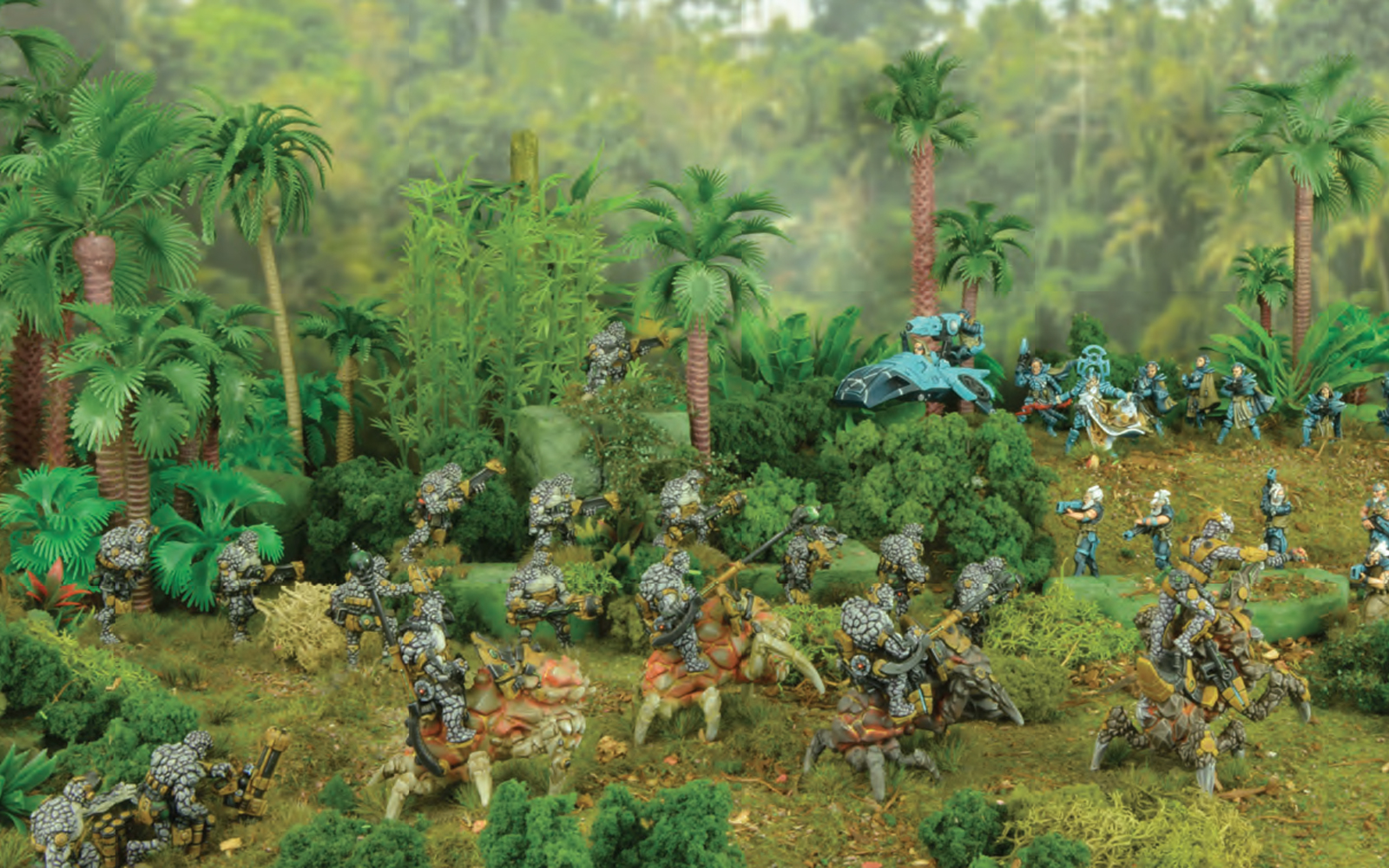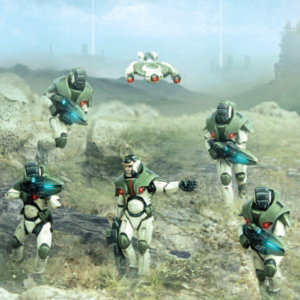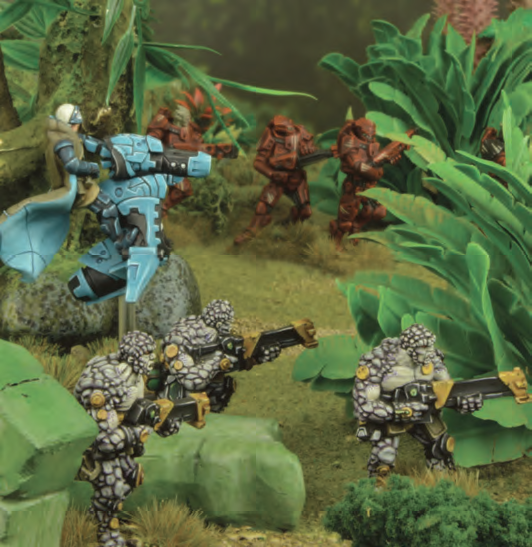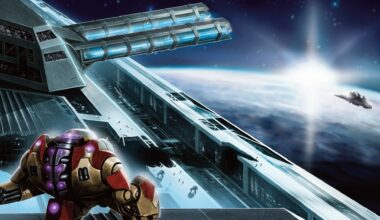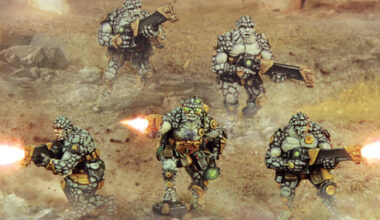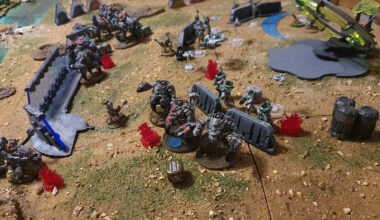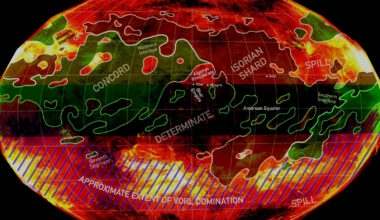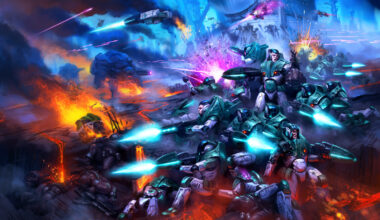In the last instalment, we explored the peoples and civilisations that were of particular import during the 5th Age, the Warring Ages of panhumanity. In this instalment, we introduce some representative factions and their rise (and fall) during the early years of the Warring Ages.
Key to the understanding of the Fifth Age is that there are no factions like those in the Sixth (Trisapient) and Seventh (IMTel) Ages: there is no PanHuman Concord, no Isorian Senatex, no NuXon Empire and no coherent swathe of an alien threat such as the Vorl Extents. Even the vast alliance of the Sixth Age’s Human League had no real equivalent in the Fifth Age, though the merchants and manufacturing centres of Alzantha were highly active as a trading hub.
It should be noted that the technological homogeneity of the peaceful, Golden Age of the Xon Times is totally lacking and Fifth Age empires are small. The fragmentation of the Xon Empire in the Fourth Age resulted in factions and empires of which the smallest contained at least 100,000 systems; in contrast, the largest of the Fifth Age factions, the Ascendency, never exceeded more than 30,000 member systems.
A way to picture the empires of the later Fifth Age would be to imagine numerous smaller empires or trade protectorates like the Seventh Age’s Algoryn Prosperate (~3,320+ systems). A key factor during much of the Fifth Age is the diversity of technology and the multiple stages of expansion and contraction that marked such a turbulent time.
Fifth Age Development Stages
The Fifth Age can be seen as being comprised of five different phases in which the number of factions varied widely. An influential factor during the whole period was the longer transit times within gates as well as the much less effective interstellar drives than are seen in the 7th Age. Whilst the drives still largely allowed ships to travel from gate to gate on Antares in similar times to the 7th age, in-system times were also increased dramatically – but we’ll go over those in a later article.
- Initially, the Fifth Age saw a period of expansion and acquisition that resulted in the rapid rise and fall of many Vorl Ordo and panhuman micro-empires and fiefdoms.
- With the gates becoming more numerous and the more rapid expansion of the dispersed Vorl Ordo, an age of internecine warfare developed that eventually led to the Time of Treachery, a period marked by few stable factions, a huge increase in isolated systems and tiny alliances between as few as half a dozen systems.
- The third stage is the rise of the Ascendancy, its initial successes against the Vorl and a similar consolidation amongst the other, smaller empires. This era culminates with the Ascendency’s first attack on Isor that left its navy – and hence influence – critically weakened.
- Even following the defeat of the Ascendancy, Isor remained committed to its isolationist policy. This allowed a resurgence of a consolidated Vorl threat, a catastrophic contraction of the Ascendency under Vorl attack, and the corresponding fragmentation of the other, minor factions into pockets of resistance. All this occurred despite the Vorl strength being considering less than in previous centuries. It could be said that the Vorl became somewhat arrogant and overconfident during this time, perhaps allowing individual Ordo to fragment.
- The final stage was initiated by the merge of NuHu and technological talent that led to a revitalised Ascendancy and the spread of better weapons and starship technology across panhuman space. This enabled the defeat of the major Vorl Ordo that left the Vorl’s desperate defence of the isolated systems left to them. The end of this era saw the final attack on Isor by the Ascendancy which led to Isor using its ultimate weapon and triggering the Fifth Collapse.
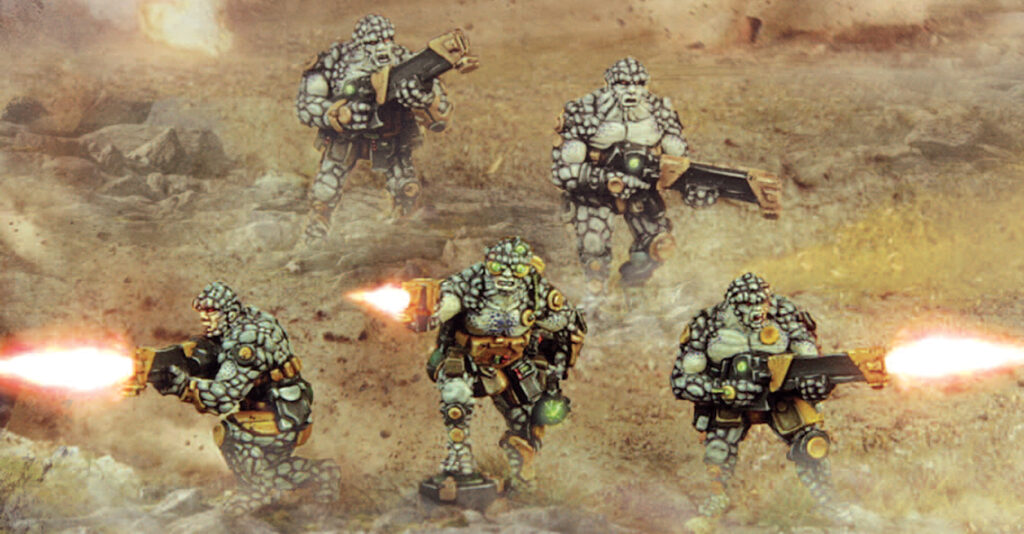
The Predecessor Factions
In the early stages of the Fifth Age, there was a broad spread of empires, fiefdoms, federations and leagues supporting political, military and mercantile alliances. As ever with panhuman culture during times of need, the governing tone of these varied from loose co-ordination to over-zealous dominance.
The more benevolent empires included numerous protectorates, the Gethderah Trade Federation, the Alzanthan Alliance (a precursor to the 6th Age Alzanthan Federation) and the NuHu-dominated League of Ha’Ruul; the notably more harsh empires included the Kerodh Despotate, the Kingdom of Ehren-Tze led by the tyrant NuHu family of the same name, many minor empires – Senn, Idess and Yohm being the most barbaric – and the military dictatorship disguised as the Saviours of Teveron which was known to use a few legions of Algoryn.
In addition, there were dozens of raider fleets and smaller squadrons. During the first millennium of the Fifth Age these are a plague on trade and the smaller systems, ravaging worlds and merchant shipping for goods, ships and personnel. These are first opposed by the Gethderah Trade Federation (GTF) but the patterns of patrolled routes and convoys spread amongst other, smaller empires and federations forcing the raider fleets to either break up and attack the weaker systems, or to consolidate and face down the navy of one of the panhuman systems or Vorl Ordo.
Typical, Early 5th Age Factions
A typical Spill fiefdom of the early years might comprise 5 to 50 systems in close proximity to one another. The prize systems along the borders of each would suffer constant raids, whilst their capitals and core systems – typically at the centre of the nation’s area – would be heavily protected.
The Kingdom of Ehren-Tze, for example, was ruled by a small NuHu family who had originally fled the Ha’Ruul after being exiled. Under the Ehren-Tze, the kingdom grew to encompass around 120 fully-occupied and dependent systems before encountering a powerful Vorl Ordo. Despite the success and the growth of its NuHu leadership, Ehren-Tze was infamous for the experiments carried out on its oppressed ‘feral’ worlds, the strict, caste-laden culture it imposed on those it conquered, and soma-technology inspired fanaticism in its warriors.
Kerodh Despotate
The fortunes of the short-lived Kerodh Despotate are a prime example of the rise and fall of the Spill empires. Initially, the Despotate’s policy was one of harsh suppression to those who resisted its attempts at annexation. Instead of imposing ruling families from afar, it provided ‘Guidance Councils’ that gave advice to a powerful, local ruler. In practice, the Councils’ ‘advice’ were diktats and the local leaders quickly found themselves extremely unpopular with their citizens. The Despotate then hired the disenfranchised and disillusioned locals as soldiers in its armed forces, arming them with cheap, easily-produced but outdated technology and relying on numbers rather than technology or tactics.
Kerodh grew to around 380 systems – one of the larger empires – before finding itself fighting the Saviours of Teveron on its western flank, the almost impossible-to-conquer Ha’Ruul worlds to the east, and two new Vorl Ordo expanding to its north and south. Whilst the Ha’Ruul could be ignored and the war against them allowed to become a stalemate, the disciplined Teveron military slowly gnawed away on Kerodh’s western flank and the Vorl cut a swathe through the Despotate’s northerly and southerly claims.
Unable to face up to its defensive responsibilities, the Despotate fractured into several, smaller fiefdoms, each of which could focus on one enemy.
The Alzanthan Alliance
Alzantha had retained much technology but was resource-poor by the time it reconnected during the Fifth Age. Mimicking the approach used by the Gethderah Trade Federation approach (see below); it established a protectorate focused on ensuring free trade across a wide swathe of the Antarean surface. With its loose commitments, this alliance attracted many independent systems and small (5-10 system) empires. Whilst the trade protectorate benefitted the Alzanthan trade hub enormously, the commitments proved too loose to survive the Vorl resurgence and the Time of Treachery.
Alzantha’s glory faded from around 950 onwards until it eventually took up with the Ascendency and once more became the trading and manufacturing centre it was capable of being – though this time a minor player in support of the Ascendency’s military might. In the subsequent Sixth Age, Alzantha was to become one of the Trisapient power-brokers and reach heights of influence only comparable with the mighty IMTel nations of the Seventh Age.
We’ll go into more detail as to how to build and map your own minor faction during this period, as well as providing a simple points-based system for designing your own forces or playing games in the Fifth Age. For now, it is worth thinking about the key elements of your own faction, such as who has the most influence, whether NuHu, a trading hub or a military, expansionist leadership, or the systems on its borders. Of course, it may be that you might like to build a force based around one of the many raider fleets that were active during this period. Whilst such raiders lived almost entirely on their ships and in their secret shipyards, they are a far cry from the influential and widespread Freeborn vardos of the 7th Age.
What’s Next
In the next instalment, we start looking at the longer-lasting and more influential factions, including the rise of Gethderah and the NuHu-dominated League of Ha’Ruul, two of the founding members of the biggest panhuman empire during the 5th Age: The Ascendancy.
